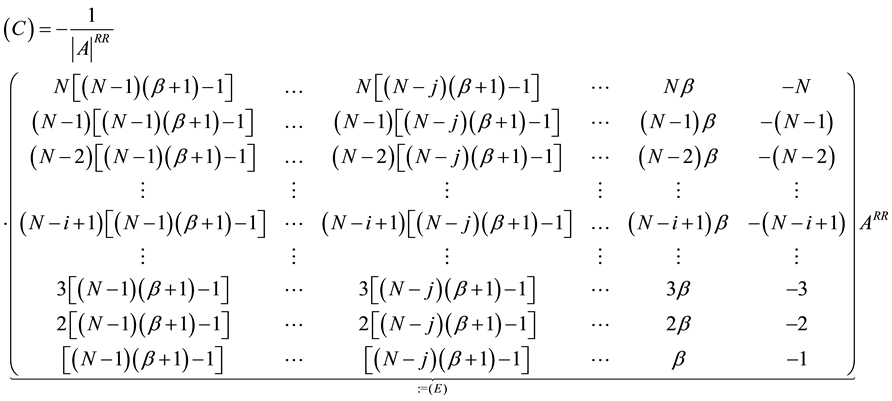Journal of Electromagnetic Analysis and Applications
Vol.06 No.12(2014), Article ID:50586,9 pages
10.4236/jemaa.2014.612038
Generalization of the Exact Solution of 1D Poisson Equation with Robin Boundary Conditions, Using the Finite Difference Method
Serigne Bira Gueye, Kharouna Talla, Cheikh Mbow
Département de Physique, Faculté des Sciences et Techniques, Université Cheikh Anta Diop, Dakar-Fann, Sénégal
Email: sbiragy@gmail.com
Copyright © 2014 by authors and Scientific Research Publishing Inc.
This work is licensed under the Creative Commons Attribution International License (CC BY).
http://creativecommons.org/licenses/by/4.0/



Received 8 August 2014; revised 2 September 2014; accepted 26 September 2014
ABSTRACT
A new and innovative method for solving the 1D Poisson Equation is presented, using the finite differences method, with Robin Boundary conditions. The exact formula of the inverse of the discretization matrix is determined. This is the first time that this famous matrix is inverted explicitly, without using the right hand side. Thus, the solution is determined in a direct, very accurate (O(h2)), and very fast (O(N)) manner. This new approach treats all cases of boundary conditions: Dirichlet, Neumann, and mixed. Therefore, it can serve as a reference for solving the Poisson equation in one dimension.
Keywords:
Robin Boundary, Poisson Equation, Matrix Inversion

1. Introduction
The Poisson equation is an elliptic differential equation well known and common to various scientific and technical domains such as physics, mathematics, chemistry, biology, etc. Its resolution generates a lot of interest to engineers, teachers, and researchers. Since, it allows analyzing in quantitative manner the studied phenomena: electrostatic, magnetostatic, wave propagation or heat diffusion in steady state. Many methods of resolution of this important equation exist, however, using the right hand side (RHS), for example, the method of Gaussian elimination or the Thomas algorithm.
Recently, a new method is proposed [1] [2] dealing with this equation in one dimensional case. This new approach, using the finite differences method (FDM), determined the inverse of the matrix obtained from algebraic equations. However, only the case of boundary conditions Dirichlet-Dirichlet (DD) [1] ; Neumann-Dirichlet (ND) and Dirichlet-Neumann (DN) [2] were treated.
The present study generalizes the solution of the Poisson equation and determines its solution for boundary conditions of third kind: Robin conditions. These mixed boundary conditions present a great interest in practice, because of combining two quantities: the function and its derivative. Here, a great innovation is that the solution is obtained in a very fast and precise way, and without using the RHS.
First, an inventory is made for possible cases of boundary conditions (DD) (DN), (ND), (RR), (RN), (NR), (DR) and (RD). Then, the cases, which must be solved are identified, considering that the first three cases of boundary problems have been solved in [1] and [2] . Then the cases (RR), (RN), (NR), were treated. The final solution is obtained, using an adequate choice of discretization, and inverting directly and exactly the discretization matrix. Thus, a numerical verification is done, considering a boundary problem of type (RR). The sensibility is determined, showing the predicated behavior of the truncation error and the very good accuracy of this new method. Finally, the cases of boundary conditions of type (DR) and (RD) are discussed and solved.
2. General Problem
The following boundary problem is to be solved:
 (1)
(1)
Here,  is, a scalar field, which depends on the real variable x. The function f(x) is a well known excitation and will be called the Right Hand Side (RHS) of the Poisson equation.
is, a scalar field, which depends on the real variable x. The function f(x) is a well known excitation and will be called the Right Hand Side (RHS) of the Poisson equation. ,
,  ,
,  , and
, and  are unknown values of
are unknown values of  and of its first derivative at points a and b, respectively. The reals
and of its first derivative at points a and b, respectively. The reals  and
and  are given constants. The coefficients
are given constants. The coefficients ,
,  ,
,  , and
, and  are also known.
are also known.
The type of boundary problem is given by the nature of the quadruplet ( ,
,  ,
,  ,
,




Depending on the value of the quadruplet of coefficients, nine (9) boundary problems exist: (DD) (ND), (DN), (NN), (RR), (RN), (NR), (DR), and (RD). The first three problems (DD), (ND), and (DN) were solved in [1] and [2] . The problem (NN) leads to a non-regular discretization matrix.
This study will determine the solutions for all the remaining cases; and therefore can serve as reference for all that will involve the 1D Poisson equation. We distinguish three parts:
・ 

・ 

・ 

3. 1D Poisson Equation with Robin-Robin (RR) Boundary Conditions
We consider the 1D Poisson equation with boundary conditions of type Robin-Robin (RR). This problem corresponds to the case, where 


where


We propose a new method of resolution of this problem. The latter requires a comfortable and adequate discretization as shown in Figure 1.
Figure 1. Discretization for Robin-Robin boundary conditions.
The mesh is composed of N + 2 points. N of them are in the interval of integration [a,b]. The other two are extra, additional, points [3] , [4] .
The mesh points 





is denoted by


At point




and the second derivative is:

The system of linear equations associated to the Boundary Problem of type Robin-Robin can be written:

At boundary points, the discretization of the conditions gives:

The approximate values of the scalar field at additional imaginary points 





and the following equation at point b

One remarks that the additional points are not included in the calculations. They allowed the use of the centered difference approximation; even at the boundary points. Therefore, the truncation error behaves like 
The vector 


Combining the Equations (5), (7), and (8); one gets the following matrix equation:




We propose, here, a new method of resolution, faster and more accurate than that of Thomas; as we have already done for the boundary problem of type (DD) [1] , and (ND) or (DN) [2] . This method is based essentially on the exact formulation of the inverse of the matrix

4. Inverse of the Matrix ARR
The matrix 



calculation of 

sults of [1] and [2] , the formula of the determinant of 

This determinant is zero for the case of boundary conditions of type Neumann-Neumann (NN), which corresponds to


Now the inverse of the matrix 

Since 



where 


The matrices (C) and (D) can be factorized and put in the form 


and for the matrix (D), one gets:

The Equation (16) shows that the matrix (E) is defined in the following manner:

From the Equation (17), it is noted that the matrix (F) is defined in the following manner:

Thus, the matrix Equation (13) becomes:

And therefore, one has the relation that provides the inverse of the matrix

So, we get



with

The Equation (22) is very important in the field of numerical resolution of differential equation in one dimension. Because it presents the exact formula of the famous matrix
A simple matrix-vector multiplication gives the solution of the differential equation. But we are not limiting there. Because, by exploiting the properties of the matrix
A further analysis of the matrix 



where

This latter equation is the same as the following [1] :

The analysis of this solution shows that one loop is sufficient to obtain the solution 

This solution in Equation (24), combined with Equation (5), corresponds to an algorithmic complexity of
The Equation (24) is solution for boundary problems satisfying 

5. Verification with a Robin-Robin (RR) Boundary Problem
We consider a scalar field

in ]0, 1[. The field 

where the parameters




of course, for
The mesh is taken as specified in Figure 1:

To verify our new method of resolution, we choose:






The computed results are shown in Table 1.
The obtained solution, with our new method, using the finite difference method, is very accurate; as Table 1 above shows. We denotes 


From Table 1, one can deduce the average relative error, which general expression is given as following:

It hols:
The sensibility of our new method can be determined by plotting the average relative error 
Table 1. Numerical results and relative error.
Figure 2. Sensibility for RR boundary conditions.
proportional to
Thus, a curve fitting of the sensibility can be given with:

where

haves like a truncation error that can be expressed in the following manner

the fourth order derivative of the exact function 
Combining the given function


So, we have demonstrated that this new method is very fast, very efficient. In addition, it is very economical in terms of occupation of memory space. It is also very accurate.
The matrix ARR is inverted analytically and in a accurate manner; independently of the RHS.
The behavior of the truncation error is very interesting as shown in the sensibility curve.
The resolution of the remaining cases Dirichlet-Robin (DR) and Robin-Dirichlet (RD) presents no difficulty. It is easy and can be done on the basis of the foregoing.
6. 1D Poisson Equation with Robin-Dirichlet and Dirichlet-Robin Boundary Conditions
6.1. 1D Poisson Equation with Dirichlet-Robin (DR) Boundary Conditions
We consider, now, a Dirichlet-Robin problem as one where the field at point a 

where


For this Dirichlet-Robin boundary problem, we propose an appropriate discretization, as shown in Figure 3.
Here, the mesh points 


size changes and becomes:


Figure 3. Discretization for Dirichlet-Robin boundary conditions.
nated as done in Equation (8).
Thus, considering the Equations (3)-(8) and adapting them to the (DR) problem, one gets the following matrix equation:

One remarks that with respect to the Robin-Robin boundary problem, there is only two changes. The first component of the vector 







6.2. 1D Poisson Equation with Robin-Dirichlet (RD) Boundary Conditions
We consider, now, a Robin-Dirichlet problem as one where the field at point b 

where


For this (RD) boundary problem, we propose the following appropriate discretization, as shown in Figure 4.
Here, the mesh points 


step size changes and becomes:


as done in Equation (7).
Thus, considering the Equations (3)-(8) and adapting them to the (RD) problem, one gets the following matrix equation:

Figure 4. Discretization for Robin-Dirichlet boundary conditions.
One remarks that with respect to the Robin-Robin boundary problem, there is only two changes. The last component of the vector F becomes






7. Conclusion
This study relates to the resolution of 1D Poisson equation, with the general case of Robin boundary conditions. The major innovation that is presented, is the exact formulation of the inverse of the discretization matrix, which is obtained from using the finite difference method. This remarkable and direct inversion of this matrix provides an elegant and efficient solution to this very important differential equation. This new proposed method of resolution is precise, economic in memory occupancy, and extremely fast. It can serve as reference for solving numerically the 1D Poisson equation and the stationary wave or heat equation.
References
- Gueye, S.B. (2014) The Exact Formulation of the Inverse of the Tridiagonal Matrix for Solving the 1D Poisson Equation with the Finite Difference Method. Journal of Electromagnetic Analysis and Applications, 6, 303-308. http://dx.doi.org/10.4236/jemaa.2014.610030
- Gueye, S.B., Talla, K. and Mbow, C. (2014) Solution of 1D Poisson Equation with Neumann-Dirichlet and Dirichlet-Neumann Boundary Conditions, Using the Finite Difference Method. Journal of Electromagnetic Analysis and Applications, 6, 309-318. http://dx.doi.org/10.4236/jemaa.2014.610031
- Kreiss, H.O. (1972) Difference Approximations for Boundary and Eigenvalue Problems for Ordinary Differential Equations. Mathematics of Computation, 26, 605-624. http://dx.doi.org/10.1090/S0025-5718-1972-0373296-3
- Engeln-Muellges, G. and Reutter, F. (1991) Formelsammlung zur Numerischen Mathematik mit QuickBasic-Program- men, Dritte Auflage. BI-Wissenchaftsverlag, Mannheim, 472-481.
- LeVeque, R.J. (2007) Finite Difference Method for Ordinary and Partial Differential Equations, Steady State and Time Dependent Problems, SIAM, 15-25. http://dx.doi.org/10.1137/1.9780898717839
- Conte, S.D. and de Boor, C. (1981) Elementary Numerical Analysis: An Algorithmic Approach. 3rd Edition, McGraw- Hill, 153-157.
- Mathews, J.H. and Fink, K.K. (2004) Numerical Methods Using Matlab. 4th Edition, Prentice-Hall Inc., New Jersey, 323-325, 339-342.
- Sadiku Matthew, N.O. (2000) Numerical Techniques in Electromagnetics. 2nd Edition, CRC Press, Boca Raton, 610-626. http://dx.doi.org/10.1201/9781420058277
- Gustafson, K. (1988) Domain Decomposition, Operator Trigonometry, Robin Condition. Contemporary Mathematics, 218, 432-437. http://dx.doi.org/10.1090/conm/218/3039
- Reinhold, P. (2008) Analysis of Electromagnetic Fields and Waves: The Method of Lines. John Wiley, Chichester, 9.







